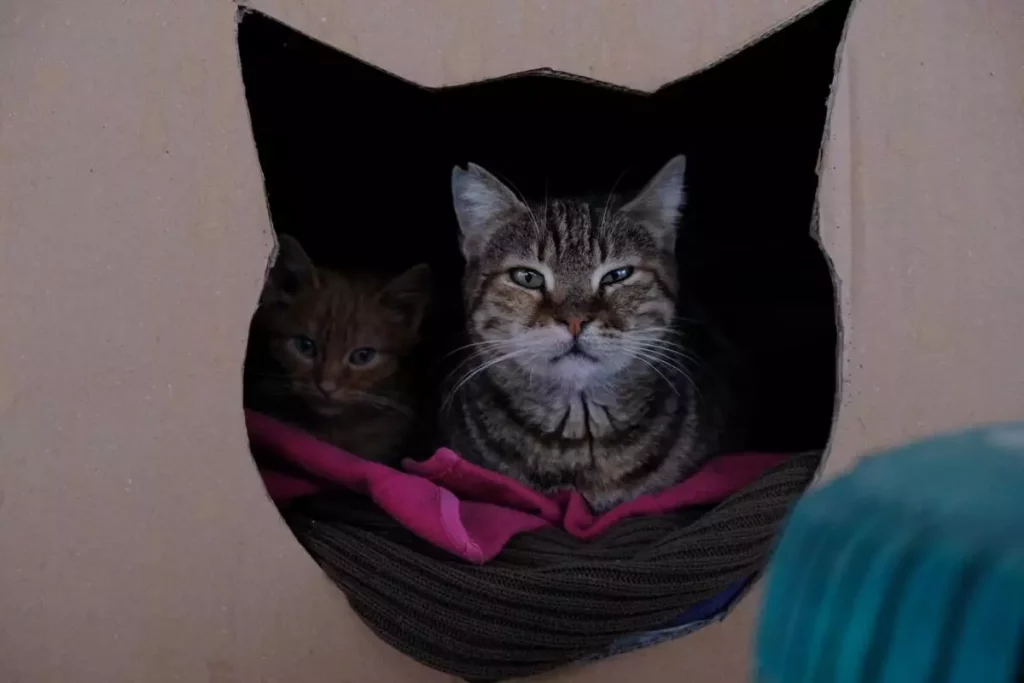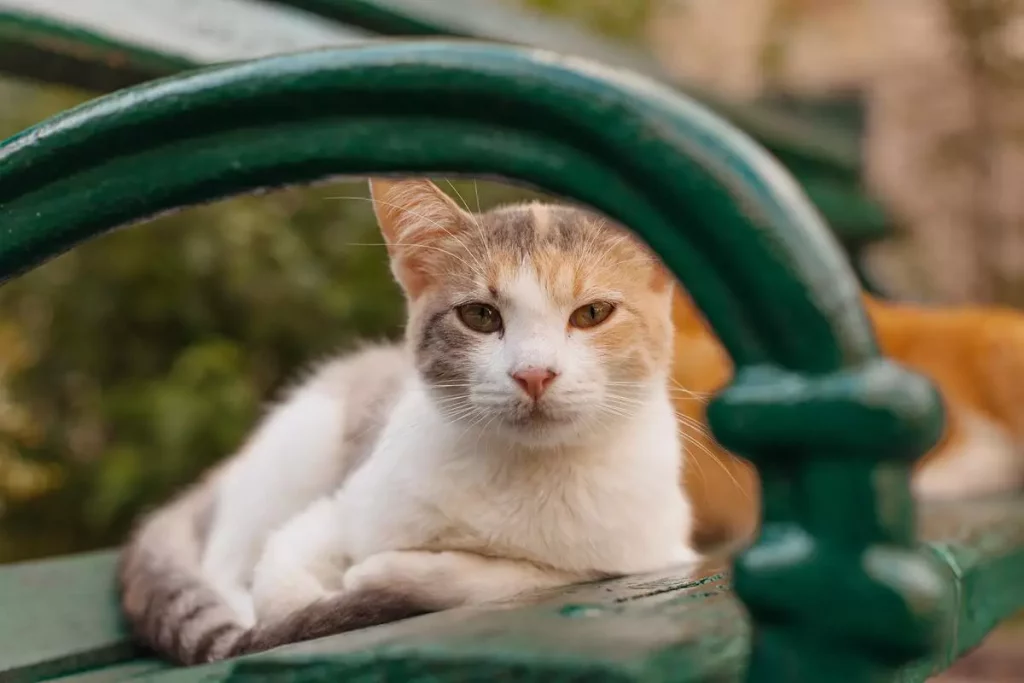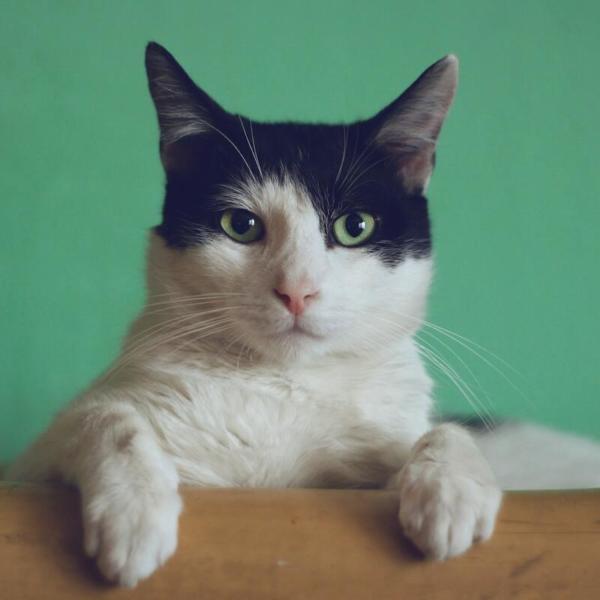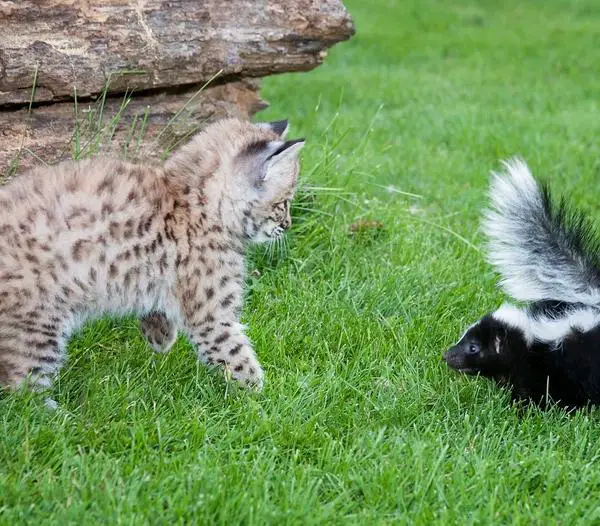It happens all the time.
When guests come over, in public, or just while relaxing on the couch, your cat is being petted.
Most cats enjoy those gentle massages and scratches and your cat is probably no exception.
But suddenly she starts hissing when you pet her, maybe in an excited or anxious manner and wants to be left alone.
The next moment she is demanding love again and you ask yourself if your cat is a schizophrenic feline.
Whether this unpredictable behavior has just developed or only occurs from time to time, you will want to differentiate aggressive behavior from simple communication to find the best training method or management approach.
So why do cats hiss when petted?
Reasons for your cat hissing at you range from affectionate pleasure hissing, over to sensitive areas or painful spots, all the way to warning signals due to fear-aggression or anxiety.
Why Does My Cat Hiss At Me When I Pet Her?
Hissing is commonly misconceived as plain aggressive vocalization.
A hissing cat is portrayed as a snarling erratic and potentially very dangerous animal.
But primarily, hissing is just a form of vocal communication between species.
The low guttural, rumbling sound may sound terrifying but it’s just their way of telling you “I feel uncomfortable or threatened in this situation”.
It’s actually a good thing that your cat is hissing because she is communicating to you that she is not okay with whatever you are doing.
A cat that has learned that hissing is wrong or didn’t have the chance to learn about feline communication in his sensible phase, is far more dangerous because she won’t warn you before she snaps.
But besides this, there are other possible causes for hissing that you probably haven’t thought about.
Your cat hissing at you when petted doesn’t necessarily mean that she is uncomfortable, it may even signal the opposite.
1. Pleasure Hissing

As I said, hissing is merely a way of communicating one’s needs, either positive or negative.
Pleasure hissing is characterized by a low, affectionate hiss that may be paired with a moan and can continue on for a longer period of time.
You can compare it to a cat’s purr, meaning that your cat is emitting pure pleasure and happiness.
It is easy to tell from his body language that she is feeling comfortable.
Lowered tail, loose stance, and relaxed mouth are all signs of a cat that is enjoying being petted.
When you stop, she may start whining to demand even more scratches.
My British Shorthair mix really loves expressing herself and she hisses a lot while playing tug of war or even with other cats.
But just because your cat is vocalizing out of arousal doesn’t mean that she would never hiss out of fear or anger.
Hissing is still primarily a warning signal and every cat is different when it comes to the amount of play or pleasure vocalization.
2. Medical Reasons
A sudden change in behavior often times comes from pain or severe discomfort.
Especially when you are touching an inflamed ear or an injured paw.
There are also several conditions that have aggression as a symptom like hypothyroidism.
Getting your cat thoroughly checked by the vet can rule out any underlying diseases and will keep your training safe.
3. Sensitive Areas
All cats prefer to be scratched on their favorite area, whether that’s the belly, back, or chest.
But many cats actually dislike being pet on the head or around the muzzle, ears, and paws especially if it wasn’t a part of their training.
You can try desensitizing your cat to like being touched in those specific places.
Veterinarians routinely need to check the mouth and ears and groomers must be able to hold your cat’s paw while trimming nails.
How to fix it: If you want to work on the paws, simply teach your cat the trick “shake” which automatically involves his paws being touched without her really noticing it.
You can use plenty of treats when working on desensitization but be careful not to encourage undesired behavior which means removing the treat when your cat starts hissing.
Getting your cat more accustomed to pats also involves you learning how to actually stroke your cat the right way.
Below is an awesome video with every cat’s favorite spots:
4. Dislike Of Certain People/ Strangers
When it comes to preferences, cats are not so different from us.
Suddenly being hugged by a stranger or getting a butt slap would throw anyone off.
While some cats are very aloof of strangers in general, others just dislike certain types of people or apparel.
If your cat wasn’t properly exposed to tall men with black coats in his early developmental stages, she might react particularly fearful towards them.
If this stranger then decides to approach, alarm bells go off.
Every attempt at physical contact will be rejected with a low hiss and clear “no”.
Some cats just don’t like their personal space invaded especially human-oriented breeds that closely bond with their owners but aren’t so sure about strangers.
That being said, a well-tempered and socialized cat shouldn’t perceive anyone as a threat when you, as the leader, introduce the person as a friend.
But many people simply don’t know how to behave.
Most strangers don’t even ask if they could pet your cat, they simply bend over with their whole body and press their sweaty palms onto your cat’s head.
This bending over paired with immediate physical contact can be perceived as a threat by nervous or fearful cats.
How to fix it: Your cat doesn’t need to be cuddling with the world but changing his perception just a little bit will do wonders.
Expose her to areas with small groups of people and slowly build your way up to busier streets.
Follow these socialization steps and create a positive experience around people by using treats or toys.
You can also ask strangers if they would be willing to throw a treat in front of your cat when passing by.
Inform people, that request to pet your cat, how to properly approach her.
They shouldn’t bend over the cat and rather come from the side taking away that threatening body language.
A scratch under the chin is much better than a pat on the head.
If your cat is still unsure about people approaching her then ask them to kneel down with a treat in their hand so your cat will be able to make contact on his own terms.
5. Warning Signal
Hissing can seemingly come out of nowhere.
But there are probably several body signals that your cat has displayed prior to this.
Depending on the situation, your cat might try to tell you “that’s enough” or “leave me alone”.
While hissing in itself is not a bad thing, finding out the reason will help you prevent or manage the situation better in the future.
When you pet your cat for a few seconds and she suddenly gives you a mad hiss, this is probably her saying that she has had enough.
She definitely has the right to tell you that but, if occurring repeatedly, it could mean that she believes to be in control of the situation and you are doing something she disapproves of.
In a nutshell, she is the one giving you commands on how you should act.
I will discuss the pack leader problem further down below which will give you an idea of where your cat is coming from.
How to fix it: Hissing as a warning signal doesn’t need to be and shouldn’t be fixed.
As I said, revoking your cat of the ability to warn will lead to a much more unpredictable cat.
Understand what your cat is uncomfortable with in this situation.
Did you squeeze her too hard or is she just not in the mood and you are forcing yourself onto her?
Give her a bit of space and let her approach you rather than vice versa.
6. You Are Not The Boss

If this is the case, your cat must have issues in more places than just the petting.
She essentially thinks that she is the boss and running the household.
We get that it sounds funny, but it’s not.
And it’s not the big dominant cats that commonly rule your life, it’s the small ones that are babied.
I know that every owner wants the best for their cat and wants them to be happy but sometimes you are unwillingly creating a problem.
But why is that a problem?
If your cat thinks of you as a bad leader, she will try it herself.
Now the debate about whether or not a pack hierarchy exists is ancient and I won’t go into any details.
Cats are not like they used to be, and domestication has greatly changed them.
I don’t recommend using any alpha training which, sadly, got closely affiliated with the word “pack leader”.
The leader (at least in my case) is a gentle, kind, and respected part of the family.
Associating leadership with dominance couldn’t be more wrong.
Every species needs guidance whether that’s coming from a parent or s boss.
If your cat thinks that you are not worthy of this title, she will try claiming ownership of resources or the couch.
She won’t need to obey commands anymore and might become snappy when corrected.
It’s essentially about the idea that you need to be in control of your cat.
At the end of the day they are animals and our society can’t work with wild behavior.
That’s why we have domesticated wolves in the first place, to fit them into our lives.
How to fix it: Leadership should be build on trust and respect. Mutual respect and understanding are the best foundation for any relationship.
You will need to have the clearest communication and the best bond possible.
This will boost your and your cat’s confidence which will help you in the next steps.
- Allude confidence. Be calm and kind when talking to your cat and do it with respect. If you don’t offer a supporting and loving attitude then you can’t expect it in return.
- Show your cat that you are serious when giving her a command. Don’t just walk away when she didn’t sit this time thinking that it will work in the future. A command always needs to be executed correctly when you ask for it.
- Regular and consistent obedience training will help your position a lot. Make it fun and enjoyable for your cat to work with you. A cat that is looking forward to a training session will have a much bigger success rate.
- Be in charge of your cat’s daily walks which start at the door. Don’t let her storm out into the open space and rather show her that she needs to respect your space and wait for your release command before going out.
- This also applies to off-leash fun. Never let your cat off-leash before she hasn’t sat, looked at you, and was released. The release command is incredibly powerful and gives you security and control over the duration and consistency of any command.
- Also, take control of his resources especially when she is guarding them. That means no free feeding and no stolen steaks from the table (which isn’t great anyway). Meal times are a perfect training opportunity to show your cat that you have full control over his food while giving her the confidence that she doesn’t have to protect it.
7. Anxiety

Cats can suffer from severe anxiety just like we do.
Separation anxiety, for example, is a condition in which a cat exhibits signs of extreme distress when being left alone.
Anxiety symptoms can include shivering, pacing, panting, destructive behavior, urination, drooling, excessive licking, etc.
There are three different reasons for fear responses to abnormal stress: fear, phobia and anxiety.
Fear is an instinctual behavior that everyone has experienced in his life several times.
It triggers our fight or flight response in the presence of a threat.
Your cat could have hissed during a pet session because she heard a loud noise from outside the door.
Now when fear becomes persistent, it’s called a phobia.
Your cat could develop a phobia from past trauma with humans or from a lack of socialization.
Especially tall men wearing certain clothes appear intimidating to cats.
Every time your cat is exposed to that trigger, she will react with a fear response that could include hissing, snapping or lunging.
Hissing is almost always self-rewarding because it achieves the desired outcome of a person walking away.
Cats can also develop a general anxiety disorder in which a cat is always on edge and anticipates a threat behind every corner.
Petting her during fearful phases can actually “hurt” her.
A cat that is always fearful has very tense muscles with lots of knots causing them to become sore.
While your intention might be to help her, you could actually make her feel more uncomfortable and therefore will receive a hiss.
If your cat is going through a sensitive phase like the second fear period (between 6-14 months old), it’s important to continuously desensitize her to his triggers.
How to fix it: Socialization never stops and while you might have missed the critical stages, it’s still not too late. Create a positive association with your cat’s trigger repeatedly by using treats or toys.
Control your cat’s environment and keep as much distance as possible at first.
You can slowly build up the exposure in baby steps to set your cat up for success.
Remember to not pet your cat when she is displaying an anxiety response because this will actually reinforce the behavior.
8. Unstable Behavior
A cat that is confident, predictable, and stable is the opposite of dangerous whereas unbalanced cats can experience a lot of anxiety and uncertainty leading to behaviors like extreme submission or dominance and switching between them.
She can react very nervous towards new stimuli and your touch could elevate his level of anxiety.
It could also be the case that your cat has learned to keep people away from her by hissing at them (conflict aggression).
This would also include situations when being petted.
Hassling a cat that is unsure of herself could trigger an aggressive response.
Unstable behavior oftentimes has an underlying medical issue so it would be best to talk to your vet.
Unbalanced temperament, on the other hand, is inherent and something you need to look out for when choosing a reputable breeder.
There are various temperament tests that you can perform on a potential kitten to determine its stability.
Recommended Reading: Do Genetics Determine My Kitten’s Temperament?
9. Aggression
Aggression (not medically induced) isn’t something that happens overnight.
It takes time to get from a friendly cat to a potentially dangerous one.
There were probably a lot of early clues that you could have picked up on and that could indicate a negative change.
Regular hissing, snapping, and lunging at you or other people is a serious behavior problem.
Take notes under which circumstances this behavior occurs and what potentially caused it.
Finding the reason behind the aggression is necessary to create a plan.
Serious aggression or reactivity towards strangers is an issue and should definitely be looked into.
There are many aggression resources on the internet and you can always reach out to a certified cat behaviorist.



Leave a Comment